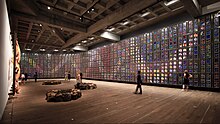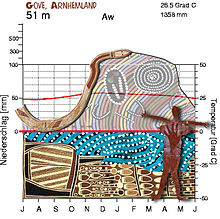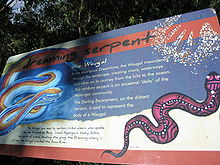Rainbow snake
The Regenbogenschlange (engl. Rainbow Serpent ) is a central figure of mythology of Aborigines , the Australian natives . She is bisexual and an important being in Dreamtime . The rainbow snake forms mountains, valleys and water holes in its appearance as a female earth spirit on earth. In her masculine appearance as the sun she creates the rainbow . The motif is also found in modern Australian art.
Names

The rainbow snake has different names from region to region, e.g. B. Baiame in the east, Ungud in the northwest, Manga in the west or Pundjel in the south of Australia. James Cowan believes that the rainbow serpent appears to be the active force in creating the world in the indigenous worldview. In almost all regions she is considered a creator being and always appears as the force that creates rivers, water holes or rain. Under the name Bolan , Kunukban , Galaru or Unjuat , it is hidden in the depths of the seas and appears on its shores.
Lore
Since all myths are only transmitted orally in the dream time , the myths vary slightly, because the creatures all refer to manifestations that occur in the immediate nature of these peoples and tribes. The rainbow snake creates mountains and valleys and is hidden in them. The didgeridoo reproduces the vibrations that were created during the physical creation of the earth.
- According to myths , the rainbow snake inhabits the few remaining water holes during the dry season and therefore controls the most precious resource of all.
- As an unpredictable opponent of the always reliable sun, it brings the hoped-for rain. It therefore stands as a symbol for the beginning of life.
- In the monsoon regions of Australia, legends tell of heroic battles between the sun, the snake and the wind. In the central desert areas, however, the seasonal weather differences are less pronounced, which is also reflected in the stories spread there.
- The rainbow serpent is considered to be the benevolent protector of his people and the ruthless persecutor of the lawbreakers. It can also devour people by the water.
- The myths that surround them serve as moral guides in everyday life and are connected to the fertility cult .
- The rainbow serpent is male in character, but since it devoured two female beings in the dream time, it absorbed the power of femininity. Their bisexuality and the occasional depiction of ouroboros biting their own tail point to an archetypal , metaphysical meaning of this mythical being, in which nature as a whole is embodied in its original state, the dream time .
- The Noongar have a dreamtime being, Wagyl , who is a smaller rainbow snake and who created the Swan River , Canning River and the associated landscapes in Western Australia in the imagination of this Aboriginal tribe . This snake hired the Noongar to protect the land while it was below the water sources.
- According to tradition, spherical granite rocks in Karlu Karlu are the eggs of the rainbow snake
- In its appearance as a rainbow it creates a connection between heaven and earth and can thus provide (spiritual) balance.
interpretation

The ethnologist Claude Lévi-Strauss has analyzed the following Yolngu myth about the rainbow snake "Yurlunggur":
- A young woman desecrated the holy water of the watering hole where the python Yurlunggur lived with her menstrual blood. The snake came out indignant, straightened up and caused a downpour that overflowed the waterhole and caused a great flood. As long as the line remained upright, rain and flooding continued. It was only when she lay down again that it quickly became dry again and life returned.
According to Lévi-Strauss' interpretation of the magical thought of the Aborigines, this story describes the local climate of Arnhem Land , as it could also be derived from a modern climate diagram.
In fact, in Northern Australia, an intense dry season is regularly followed every year by an intense rainy season with heavy rainfall and spring tides that flood the country several dozen kilometers into the country. During this time there is only an insecure and limited food supply for the Yolngu, who have to withdraw to higher ground. In the transition period, on the other hand, there is abundance and life. If you look at the entire myth, the relationship to human life becomes clear: the menstruating woman symbolizes the still “impure”, inferior femininity that still needs to be fertilized, while the rain symbolizes the fertilizing, pure and superior masculinity.
literature
- James Cowan: Dreamtime Revelations. The Aboriginal Spiritual Knowledge . Lüchow-Verlag, Stuttgart 2004, ISBN 3-363-03050-9 .
- Gerhard Leitner: The Aborigines of Australia . Beck-Verlag, Munich 2006, ISBN 3-406-50889-8 .
- R. Lewis: The Beginner's Guide to Australian Aboriginal Art. The symbols, their meanings and some Dreamtime stories . Gecko Books, Keswick, SA 2009, ISBN 978-0-9803521-6-0 .
Web links
- Presentation on the myth of the rainbow snake ( Memento from February 20, 2008 in the Internet Archive )
- Representation as Ouroboros
Individual evidence
- ↑ Lewis: Australian Aboriginal Art, p. 11 (see literature)
- ↑ Cowan: Revelation, pp. 46f. (see literature)
- ↑ Cowan: Revelation, p. 48 (see literature)
- ↑ Lewis: Australian Aboriginal Art. P. 13 (see literature)
- ^ Claude Lévi-Strauss: The wild thinking. Translation by Hans Naumann. Suhrkamp, Frankfurt am Main 1968.


